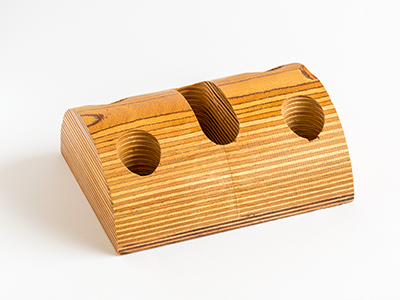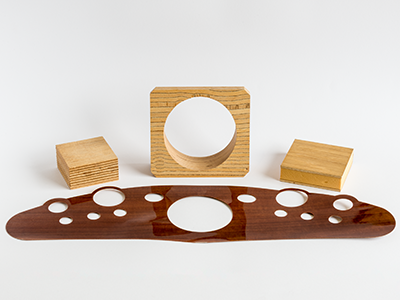- Home
- Laminated wood
Laminated wood
Laminated wood, or glulam, is a highly versatile engineered material, with applications ranging from construction to furniture manufacturing, and even more specialized uses such as thermal and dielectric insulation. Thanks to its composite structure, it offers numerous advantageous technical features, making it an innovative solution even in less traditional fields.
Technical characteristics of laminated wood
- Mechanical strength and structural stability
The lamination process improves the wood’s resistance to mechanical stresses, distributing tension through multiple layers oriented in a complementary way. This arrangement optimizes load-bearing capacity, making it ideal for beams, arches, and load-bearing structures, with generally higher strength than solid wood. - Dimensional stability
Unlike solid wood, which can deform with humidity and temperature variations, laminated wood is highly dimensionally stable. This is essential for use in environments with variable humidity or exposed to thermal fluctuations. - Thermal insulation
Thanks to its natural cellular structure, wood is already a good thermal insulator; lamination further enhances this property. Laminated wood has a lower thermal conductivity compared to other building materials such as steel and concrete, retaining heat inside the building during winter and keeping it outside during summer. It is therefore ideal for low-energy buildings, contributing to optimal thermal efficiency and reducing heating and cooling costs. - Dielectric insulation
Another lesser-known feature of laminated wood is its ability to act as an electrical insulator. Wood, being naturally non-conductive, can be used in contexts where dielectric insulating properties are required. This property, combined with structural stability and thermal resistance, makes laminated wood particularly suitable for applications in electronics, the telecommunications industry, and for insulating components in high-voltage industrial environments. - Environmental sustainability
Laminated wood, produced from renewable and sustainably managed sources, represents an ecological choice. Its manufacturing process allows the use of lower-quality timber, optimizing resources and reducing waste.
Uses of laminated wood
- Civil and industrial construction
Laminated wood is widely used in structural construction due to its strength and ability to support heavy loads. Employed in beams, arches, and columns, it is suitable for residential buildings and industrial structures, including large-span roofs, combining aesthetics and functionality. - Thermal insulation in low-energy buildings
Thanks to its low thermal conductivity, laminated wood is perfect for low-impact energy buildings and interior insulation. It is used to clad walls and floors, helping improve energy efficiency and living comfort, especially in extreme climate conditions. - Electrical structures and components
In the industrial sector, laminated wood is used as an insulating material for components requiring dielectric insulation, such as panels for electrical cabins or insulating supports for electrical systems. In these contexts, laminated wood not only provides the necessary insulation but also ensures stability and durability over time, making it a safe and high-performance solution. - Design and furniture
In the furniture sector, laminated wood is used to create innovative and durable designs, adapting to various finishes and even complex shapes. It is highly sought after for the production of curved furniture, shelves, and surfaces for household appliances, thanks to its insulating properties and structural stability. - Use in environments with thermal and electrical risk
Thanks to the combination of its thermal and dielectric insulating properties, laminated wood is an optimal choice for industrial environments with high thermal and electrical exposure, such as control stations and server rooms, where insulation and safety are essential.
Threaded bars and nuts in Bakelized wood are also produced, from Ø M5 to Ø M56, length upon request.
In conclusion, laminated wood is a versatile, functional, and sustainable solution that, thanks to its thermal and dielectric characteristics, finds innovative applications in technologically advanced sectors, as well as being a classic in construction and furniture.





